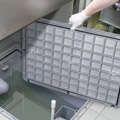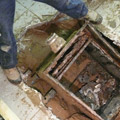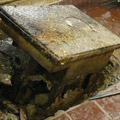
A Canplas Endura 50 gpm grease interceptor is shown here. As
of mid-May, Papa Gino’s had 117 Endura interceptors installed in its restaurant
locations. (Photos courtesy Papa Gino’s Inc./Canplas)
Grease management is becoming a more and more significant challenge for commercial food-service operations. Primarily this has come about through increasing awareness of the issues associated with FOG (fat, oil and grease) accumulation in municipal sewer treatment systems. In turn, this has progressively found its way back to the restaurant operator in the form of local, municipal and even state ordinances.
One of the most significant challenges for relative newcomers to this market is to make the entrenched engineers, code-enforcement agencies and installers aware that times have changed and there are now proven, effective, efficient and durable alternatives to the traditional metal grease trap that has prevailed throughout the past two decades.
While many food-service establishments struggle with traditional technology and its acknowledged operational challenges, others like Papa Gino’s Inc., a Massachusetts-based company that operates more than 370 company-owned and franchised restaurants throughout the Northeast, have proactively taken the issue of grease management in hand and have seen the resulting benefits.

Papa Gino’s Inc., a company that operates more than 370
company-owned and franchised restaurants throughout the Northeast, has turned
to plastic grease interceptors with great success.
Metal Troubles
Aaron Ancello, the director of facilities at Papa Gino’s responsible for managing ongoing repairs, maintenance, municipal code compliance and capital improvements for the company-owned restaurants, had been working with Everett, Mass.-based plumbing contractor RJ Morello Inc., on sourcing alternative interceptors in an effort to lower maintenance costs and extend the life of the capital investment.“A large majority of Papa Gino’s and D’Angelo (another brand in the Papa Gino’s family) restaurants had internal recessed steel grease interceptors installed,” Ancello says. “These units required significant ongoing maintenance and capital funding for repairs and replacements. The maintenance items involved had constant cover issues with leaking seals allowing the escape of foul odor and liquid. There were broken or cross-threaded bolts that made it difficult to get in and out of the trap for maintenance, and there was rusting like you wouldn’t believe, which affected the baffles and the tank itself.”
Ancello says the biggest quandary with the metal versions is maintaining the integrity of the seal due to lid malfunction.
“It’s the main issue. You have constant rusted or broken bolts,” he says. “After a few cleanings you have trouble sealing because there are many, many failed seams. It’s a substantial issue. Torque is involved. Person A tightens it differently than Person B, who does it differently than Person C, which ruins the seal.”
And a malfunctioning metal grease interceptor can open up the proverbial can of worms.
“With the metal traps you don’t know if you have 100 percent performance because of those metal baffles,” Ancello says. “And once the seals go, you have leaking issues with water coming up out of the unit, which is not good either. You are potentially opening yourself up to plumbing problems because that grease could escape from the metal unit.”
Ancello found the company was replacing the metal interceptors every three to five years, which was a significant problem for the company because of day-to-day operational issues, as well as the days of down time needed while repairs or replacement efforts were undertaken.
“Which was costly for capital,” Ancello says. “They run about $2,000 to $4,000 depending on the size of the unit and depending on if they are recessed or surface-mounted.”
Andrew Bird, the business development manager/plumbing products for Barrie, Ontario-basedCanplas, which produces the Endura Grease Interceptor line, says a malfunctioning metal grease interceptor brings with it a chain reaction of trouble.
“At best, it’s $2,000 to replace; however, this cycle inevitably repeats,” Bird says. “Let’s say you are fortunate and you only repeat the replacement cycle three times. You are at least $6,000 worse off in unit cost and installation alone, plus the ‘big picture’ is you have three times the carbon footprint - manufacturing, distribution, disposal and still more FOG reaching the municipal sewer systems.”
What Ancello was experiencing in his restaurants, unfortunately, is something Bird sees on a regular basis.
“Environmentally, this situation is less than ideal,” Bird says. “The operational lifetime for the steel units used by Papa Gino’s in their locations is consistent with the industry as a whole.”

Metal grease interceptors can be susceptible to a variety of
malfunctions, which can lead to additional plumbing and environmental problems.
Plastic To The Rescue
Searching for an answer to an ongoing costly problem, Ancello came across Canplas’ Endura injection-molded thermoplastic grease interceptor model and tested the unit.“I was skeptical when I first tried it,” Ancello admits. “I’m thinking you’ve got a plastic grease trap, what about hot and cold and expansion?”
But Ancello’s fears were quickly assuaged.
“It’s a night and day difference,” he says. “I can’t jump up and down enough for the plastic one. The main noticeable thing is the plastic one seals. It has a clip system on the lid. The clips have the same torque every time. There is no rust. The thing continues to operate no matter what you do unless you are lazy and don’t put the baffles back in.”
He also does not hesitate installing the plastic interceptors in areas of high traffic.
“People walk all over them,” Ancello says. “With the metal ones, people walk on them and put pressure on the gaskets. I roll dough carts over the plastic ones and I have no issues.”

One major issue with metal grease interceptors is
maintaining the seal due to compromised bolts on the lid.
Code Compliance
In solving his dilemma, Ancello also had to make sure the plastic grease interceptors conformed to local codes.“Part of my responsibility is ensuring we meet all applicable code requirements all the way down to the municipal level,” says Ancello, who notes Massachusetts has its own approval board for plumbing products. “Canplas was the first plastic grease interceptor to gain approval in the state back in 2004.”
Ancello also found the Endura model met both the American Society of Mechanical Engineers (ASME) and Plumbing and Drainage Institute (PDI) approval standards. However, Ancello notes he is not permitted to universally install the Canplas plastic model in all the company’s restaurants.
“An automatic recovery device is mandated in the state of Connecticut and some municipalities in Massachusetts,” says Ancello, who usesThermaco’s Big Dipper interceptor in the company’s restaurants that require the automatic recovery device. He also mentioned Thermaco manufactures a larger plastic Trapzilla model.
Making The Switch
Thus far, 117 plastic interceptors have been installed acrossPapa Gino’s370 locations. The company’s South Station, Mass., restaurant was the first to install the plastic interceptor in April 2007 (specified as a 25 gpm unit; the Endura model is available in units ranging from 15 to 50 gpm).“All replacement and upgrades are now done where a hydro-mechanical interceptor is acceptable by the local municipality,” Ancello says. “In addition, we spec the Endura for all new restaurants where an internal hydro-mechanical interceptor can be used.”
Ancello confirms from the capital purchase perspective, the units are not only comparable to their steel counterparts, but in some instances could be half the cost by the time installation is completed.
“The biggest benefit, though, is the reduction in maintenance and repair costs as a result of moving to the plastic units,” he says. “There are no more issues with corrosion, warping of baffles, foul odors or loss of performance. Every unit works today just as well as it did the first day it was installed and will continue to do so.”
Bird predicts the use of plastic grease interceptors will continue to increase over time.
“The metal units can require three to five changes over a 25-year period,” he says. “In the operational life of a food-service location, once built and commissioned, regardless of if the ownership changes hands or remains, the plumbing system, in particular, rarely undergoes any significant change - grease interceptor included.”
